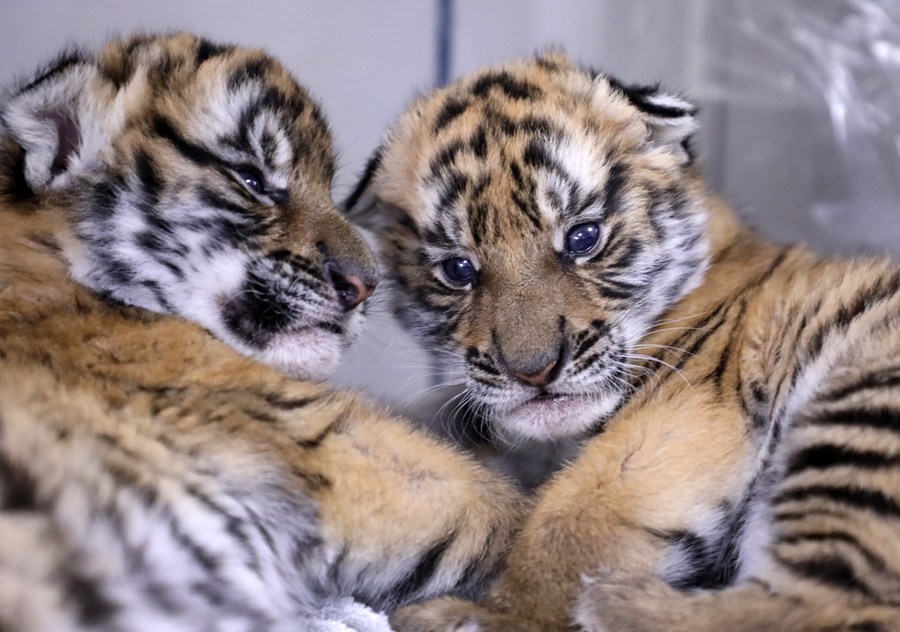
Twin cubs of South China tiger born on Dec. 31, 2021 are seen at the research base of south China tiger breeding in Shaoguan City of south China's Guangdong Province, Jan. 20, 2022. (Xinhua/Huang Guobao)
by Zheng Jingxia, Xiong Jiayi and Xie Chunhong
GUANGZHOU, July 30 (Xinhua) -- Braving scorching summer heat, tourists were still excited to visit the tiger kindergarten in Shaoguan City, south China's Guangdong Province. Surrounded by flocks of people, Honghong, the one-year-old cub, roamed toward the glass wall and looked at visitors with curiosity, sniffing as if there were nothing in between.
The kindergarten is part of the South China tiger breeding base located in the mountainous city. Dedicated to the breeding, wild training, and popular science education of South China tigers, the breeding base is currently home to 14 such big cats, with four being kept at the kindergarten.
Lei Shengqiao, an experienced keeper at the breeding base, said that cubs are hand-raised at birth and then transferred to the kindergarten when they turn three months old.
One of the main tasks of the kindergarten is to provide wild training for young tigers, Lei said, adding that the facility is equipped with climbing frames, wooden stakes, and various ball toys, all specially designed for exercises aimed at cultivating the cubs' wild nature.
South China tigers are a subspecies unique to China. The big cats suffered population losses due to habitat degradation and were once on the verge of extinction.
China also hosts Siberian tigers. To rehabilitate dwindling tiger populations, the country has taken a slew of measures to protect the animals, including putting a stop to deforestation in the forest areas of the northeastern region, establishing various types of natural reserves, and cracking down on poaching.
Reintroduction of captive-bred animals, however, is never easy. Xu Jian, a professor at Shaoguan University, said that the crucial factor impacting the restoration of South China tigers is fecundity.
Inbreeding remains a problem constraining the healthy population growth of the species as it could lead to a lower survival rate, Xu added.
He highlighted solid government support at both national and local levels in bolstering research on artificial breeding. As a result, visible progress has been made in breeding South China tigers in recent years.
Last year, the population of South China tigers in the country stood at over 240, compared with merely 18 in the 1950s, data from the Chinese Association of Zoological Gardens showed.
The number of wild Siberian tigers in the country is also on the rise, with figures up to about 60 from about 20 in the 1990s, according to the National Forestry and Grassland Administration.
The expanding tiger population is attributed to China's biodiversity endeavors over the years. Committed to human-nature harmony, the country has long put biodiversity restoration and ecosystem conservation high on its policy agenda.
To foster a better ecosystem, China has implemented a raft of measures, including building the national parks system, setting red lines for ecological conservation, and strengthening in-situ and ex-situ conservation.
In particular, the country has carried out systematic rescue projects for endangered species. Under these projects, endangered animals have expanded in population, and some species have managed to make a comeback to the wild.
For keepers like Lei, nothing could be more rewarding than seeing South China tigers thrive in their habitats. "I hope that tigers in our breeding base could be released to the wild one day." Enditem
(Ye Ziyu, Liu Yangjiadi, Wu Baorong and Yan Xinyi also contributed to the story.) ■












